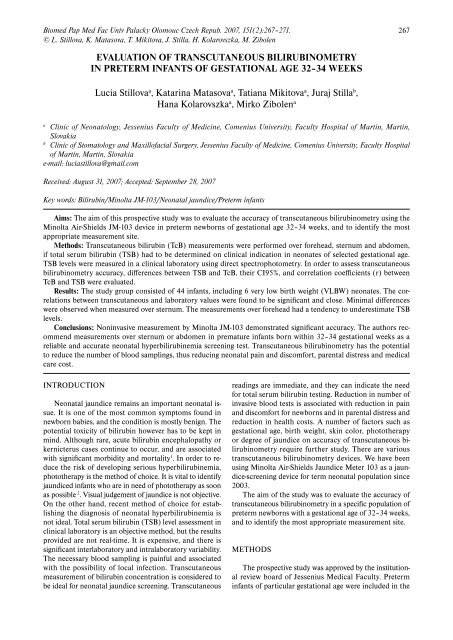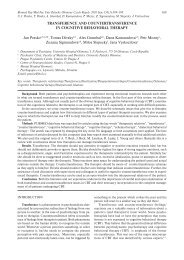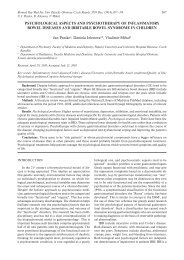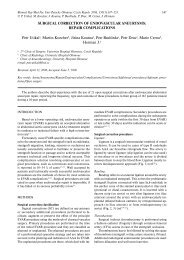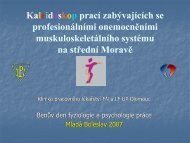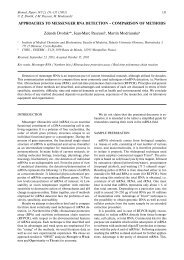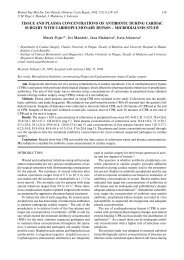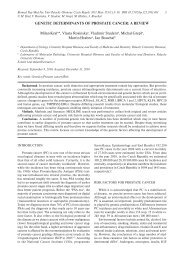EVALUATION OF TRANSCUTANEOUS ... - ResearchGate
EVALUATION OF TRANSCUTANEOUS ... - ResearchGate
EVALUATION OF TRANSCUTANEOUS ... - ResearchGate
Create successful ePaper yourself
Turn your PDF publications into a flip-book with our unique Google optimized e-Paper software.
Biomed Pap Med Fac Univ Palacky Olomouc Czech Repub. 2007, 151(2):267–271.<br />
© L. Stillova, K. Matasova, T. Mikitova, J. Stilla, H. Kolarovszka, M. Zibolen<br />
267<br />
<strong>EVALUATION</strong> <strong>OF</strong> <strong>TRANSCUTANEOUS</strong> BILIRUBINOMETRY<br />
IN PRETERM INFANTS <strong>OF</strong> GESTATIONAL AGE 32–34 WEEKS<br />
Lucia Stillova a , Katarina Matasova a , Tatiana Mikitova a , Juraj Stilla b ,<br />
Hana Kolarovszka a , Mirko Zibolen a<br />
a<br />
Clinic of Neonatology, Jessenius Faculty of Medicine, Comenius University, Faculty Hospital of Martin, Martin,<br />
Slovakia<br />
b<br />
Clinic of Stomatology and Maxillofacial Surgery, Jessenius Faculty of Medicine, Comenius University, Faculty Hospital<br />
of Martin, Martin, Slovakia<br />
e-mail: luciastillova@gmail.com<br />
Received: August 31, 2007; Accepted: September 28, 2007<br />
Key words: Bilirubin/Minolta JM-103/Neonatal jaundice/Preterm infants<br />
Aims: The aim of this prospective study was to evaluate the accuracy of transcutaneous bilirubinometry using the<br />
Minolta Air-Shields JM-103 device in preterm newborns of gestational age 32–34 weeks, and to identify the most<br />
appropriate measurement site.<br />
Methods: Transcutaneous bilirubin (TcB) measurements were performed over forehead, sternum and abdomen,<br />
if total serum bilirubin (TSB) had to be determined on clinical indication in neonates of selected gestational age.<br />
TSB levels were measured in a clinical laboratory using direct spectrophotometry. In order to assess transcutaneous<br />
bilirubinometry accuracy, differences between TSB and TcB, their CI95%, and correlation coefficients (r) between<br />
TcB and TSB were evaluated.<br />
Results: The study group consisted of 44 infants, including 6 very low birth weight (VLBW) neonates. The correlations<br />
between transcutaneous and laboratory values were found to be significant and close. Minimal differences<br />
were observed when measured over sternum. The measurements over forehead had a tendency to underestimate TSB<br />
levels.<br />
Conclusions: Noninvasive measurement by Minolta JM-103 demonstrated significant accuracy. The authors recommend<br />
measurements over sternum or abdomen in premature infants born within 32–34 gestational weeks as a<br />
reliable and accurate neonatal hyperbilirubinemia screening test. Transcutaneous bilirubinometry has the potential<br />
to reduce the number of blood samplings, thus reducing neonatal pain and discomfort, parental distress and medical<br />
care cost.<br />
INTRODUCTION<br />
Neonatal jaundice remains an important neonatal issue.<br />
It is one of the most common symptoms found in<br />
newborn babies, and the condition is mostly benign. The<br />
potential toxicity of bilirubin however has to be kept in<br />
mind. Although rare, acute bilirubin encephalopathy or<br />
kernicterus cases continue to occur, and are associated<br />
with significant morbidity and mortality 1 . In order to reduce<br />
the risk of developing serious hyperbilirubinemia,<br />
phototherapy is the method of choice. It is vital to identify<br />
jaundiced infants who are in need of phototherapy as soon<br />
as possible 2 . Visual judgement of jaundice is not objective.<br />
On the other hand, recent method of choice for establishing<br />
the diagnosis of neonatal hyperbilirubinemia is<br />
not ideal. Total serum bilirubin (TSB) level assessment in<br />
clinical laboratory is an objective method, but the results<br />
provided are not real-time. It is expensive, and there is<br />
significant interlaboratory and intralaboratory variability.<br />
The necessary blood sampling is painful and associated<br />
with the possibility of local infection. Transcutaneous<br />
measurement of bilirubin concentration is considered to<br />
be ideal for neonatal jaundice screening. Transcutaneous<br />
readings are immediate, and they can indicate the need<br />
for total serum bilirubin testing. Reduction in number of<br />
invasive blood tests is associated with reduction in pain<br />
and discomfort for newborns and in parental distress and<br />
reduction in health costs. A number of factors such as<br />
gestational age, birth weight, skin color, phototherapy<br />
or degree of jaundice on accuracy of transcutaneous bilirubinometry<br />
require further study. There are various<br />
transcutaneous bilirubinometry devices. We have been<br />
using Minolta Air-Shields Jaundice Meter 103 as a jaundice-screening<br />
device for term neonatal population since<br />
2003.<br />
The aim of the study was to evaluate the accuracy of<br />
transcutaneous bilirubinometry in a specific population of<br />
preterm newborns with a gestational age of 32–34 weeks,<br />
and to identify the most appropriate measurement site.<br />
METHODS<br />
The prospective study was approved by the institutional<br />
review board of Jessenius Medical Faculty. Preterm<br />
infants of particular gestational age were included in the
268 L. Stillova, K. Matasova, T. Mikitova, J. Stilla, H. Kolarovszka, M. Zibolen<br />
study if visual observation of jaundice raised concern for<br />
risk of hyperbilirubinemia and TSB determination was<br />
necessary within the first two weeks of their life. The criteria<br />
for exclusion were phototherapy, exchange transfusion<br />
and major congenital malformations.<br />
The Minolta JM-103 probe was placed against the<br />
forehead, sternum and abdomen of the infant in a supine<br />
position. A computerized average of three consecutive<br />
readings over each measurement site was displayed as the<br />
transcutaneous bilirubin (TcB) level in μmol/l. Blood samples<br />
were drawn from a peripheral vein within 10 minutes<br />
of transcutaneous measurement. TSB levels were measured<br />
in our hospital’s clinical chemistry laboratory using<br />
the method of direct spectrophotometry. One transcutaneous<br />
measurement and one laboratory measurement were<br />
performed in each newborn, in order to acquire only one<br />
data set per infant. Pearson linear regression analysis was<br />
performed, obtaining correlation coefficients (r) between<br />
TcB and TSB. p values of less than 0.05 were considered<br />
to be statistically significant. In order to assess the accuracy<br />
of noninvasive bilirubin concentration measurement,<br />
differences (∆) between TSB and TcB, and their 95% confidence<br />
intervals (CI95%) were evaluated.<br />
RESULTS<br />
Fig. 1. Linear regression plots of TSB versus JM-103 TcB<br />
measurements obtained from different body sites<br />
(forehead, sternum, abdomen) of the study group<br />
(n = 44).<br />
A total of 44 jaundiced preterm infants (26 males,<br />
18 females) of Caucasian race, including 6 VLBW neonates<br />
(with birth weight less than 1500 g), were evaluated.<br />
The infants born within 32–34 gestational weeks<br />
who required TSB level measurement on clinical indication<br />
within the first two weeks of life were included in the<br />
study. Newborns receiving phototherapy, post exchange<br />
transfusion and those with major congenital malformations<br />
were excluded from the study group. Gestational<br />
age at birth ranged from 32 to 34 weeks [x (mean) = 33.5,<br />
SD = 0.7], postnatal age from 0 to 13 days (x = 4.8, SD<br />
= 2.7), birth weight from 1110 to 2400 g (x = 1955, SD =<br />
308.4). TSB ranged from 38.3 to 263.7 μmol/L (x = 159.4,<br />
SD = 42.3).<br />
The correlations between TSB and TcB were found<br />
to be significant and close when measured at any of the<br />
three sites. The correlation coefficients for TSB versus<br />
TcB measurements over forehead, sternum and abdomen<br />
were 0.85, 0.81 and 0.73, respectively. (Figure 1).<br />
Mean differences (∆) between TSB and TcB and<br />
their CI95% for particular measurement sites are shown<br />
in Table 1. Transcutaneous measurements over sternum<br />
and abdomen show signifi cant differences (p ≥ 0.05).<br />
Minimal differences were found when measured over sternum.<br />
Measuring over abdomen seems to be also suitable<br />
for hyperbilirubinemia screening. The measurements over<br />
forehead had a tendency to underestimate serum bilirubin<br />
levels significantly (p < 0.05). (Figure 2).
Evaluation of transcutaneous bilirubinometry in preterm infants of gestational age 32–34 weeks<br />
269<br />
Difference between TcB and TSB (mean and CI95%)<br />
20<br />
10<br />
0<br />
-10<br />
-20<br />
-30<br />
Preterm newborns<br />
X n.s. n.s.<br />
forehead sternum abdomen<br />
-40<br />
μmol/L<br />
Fig. 2. Mean differences (μmol/L) between transcutaneous bilirubin (TcB) and total serum bilirubin (TSB) values and<br />
their 95% confidence intervals, according to the site of transcutaneous measurements. Statistical significance<br />
is specified (forehead: p < 0.05 X; sternum: p ≥ 0.05 n.s.; abdomen: p ≥ 0.05 n.s.).<br />
DISCUSSION<br />
The Minolta Jaundice Meter-103 determines the yellowness<br />
of the subcutaneous tissue of a newborn infant<br />
by measuring the difference between optical densities for<br />
light in the blue and green wavelength regions. Since the<br />
optical density difference shows a linear correlation with<br />
serum bilirubin concentration, it is converted into TSB<br />
and indicated digitally 3 . Advantages of the noninvasive<br />
measuring technique are real-time results, cost-effectiveness<br />
and avoidance of pain and local infection. Minolta<br />
JM-103 TcB assessment demonstrates significant accuracy<br />
compared to TSB and can be used as a screening test to<br />
identify the need for blood sampling for TSB levels in<br />
term and near-term newborn infants 3–7 . Ho et al. (2006)<br />
reported that combining the use of TcB JM-103 and the<br />
75th centile in Bhutani’s nomogram as the cut-off level<br />
can identify all cases of signifi cant hyperbilirubinemia<br />
in term and near-term newborns 8 . Maisels et al. (2004)<br />
reported that in the black population the JM-103 TcB<br />
measurements were less accurate than in the other population<br />
groups 7 . Although Engle et al. (2005) did not consider<br />
JM-103 to be a reliable substitute for laboratory TSB<br />
measurement, they suggested that in term and near-term<br />
neonates it may facilitate management of hyperbilirubinemia<br />
by reducing the number of TSB determinations<br />
required 9 .<br />
Use of the Minolta JM-103’s two-point method for<br />
TcB measurement reduces the influence of neonatal skin<br />
maturation level on the results accuracy 10 . However, the<br />
use of this particular device in premature infants has not<br />
been satisfactorily validated, although hyperbilirubinemia<br />
in preterm infants is an important issue. The incidence of<br />
hyperbilirubinemia in premature neonates is higher and<br />
its course is more serious and prolonged, in comparison<br />
with term infants 11 . Yasuda et al. (2003) included 24 preterm<br />
infants in their Minolta JM-103 study group, and<br />
reported a similar regression line between TcB and TSB to<br />
term infants 3 . Namba and Kitajima (2007) measured TcB<br />
over forehead in preterm and VLBW Japanese infants.<br />
They concluded that the TcB measurements were safe<br />
and accurate in these infants. However, they reported a<br />
low reliability in patients whose birthweights were lower<br />
than 1000 g or whose gestational ages were shorter than<br />
28 weeks 12 .<br />
The accuracy of transcutaneous bilirubinometry in<br />
preterm infants was otherwise studied only using devices<br />
such as BiliCheck or the older Minolta JM-102. The conclusions<br />
are conflicting. According to Nanjundaswamy et<br />
al. (2004) BiliCheck measurements can accurately predict<br />
TSB values lower than 188 μmol/l in a multiracial preterm<br />
and term neonatal population 13 . In agreement, Willems<br />
et al. (2004) reported the BiliCheck as reliable in very<br />
preterm infants of gestational age less than 30 weeks 14 .
270 L. Stillova, K. Matasova, T. Mikitova, J. Stilla, H. Kolarovszka, M. Zibolen<br />
Table 1.<br />
Forehead (∆F) Sternum (∆S) Abdomen (∆B)<br />
∆(μmol/l) –22.4 1.7 4.3<br />
CI 95% (μmol/l) +/– 8.4 +/– 10.7 +/– 12.0<br />
p p < 0.05 p ≥ 0.05 p ≥ 0.05<br />
On the other hand, Eyw et al. (2006) recommended the<br />
BiliCheck as a useful screening tool for neonatal jaundice<br />
in the neonates with gestation above 32 weeks 15 . Rubaltelli<br />
et al. (2001) recommended BiliCheck as a reliable substitute<br />
of TSB determination in newborns who are of more<br />
than 30 weeks of gestation 16 . Also Knupfer et al. (2001)<br />
were given reliable results only in newborns older than<br />
30 weeks of gestation 17 . Jangaard et al. (2006) reported<br />
that the Bilicheck instrument was less sensitive in their<br />
small sample of preterm infants 18 . According to Mercanti<br />
et al. (2007), although the need for phototherapy cannot<br />
be determined by BiliCheck measurements in preterm<br />
infants, the TcB is reliable when its value is under the<br />
limits for phototherapy 19 . Minolta JM-102 was found to be<br />
a reliable bilirubin measurement device in VLBW infants,<br />
enabling reduction in the need for plasma bilirubin measurements<br />
without missing true hyperbilirubinemia 20 .<br />
Among modern measurement methods the Minolta<br />
JM-103 device appears to be the most effective noninvasive<br />
hyperbilirubinemia screening tool in preterm infants.<br />
Moreover, the accuracy of JM-103 in predicting TSB in<br />
term and near-term infants was higher compared with<br />
BiliCheck at all TSB levels 21 . In a previous study we found<br />
that the Minolta JM-103 measurements over forehead<br />
tended to underestimate TSB levels in term infants with<br />
TSB more than 220 μmol/l. Measurements over sternum<br />
and abdomen accurately predicted TSB levels 4 . In the<br />
current study, we also report similar results in preterm<br />
infants. According to the presented results, the measurements<br />
over forehead in preterm neonates of the particular<br />
gestational age had a tendency to underestimate TSB<br />
levels, which is in agreement with the study of Sanpavat<br />
et al. (2004) (ref. 5 ). In preterm infants phototherapy is<br />
indicated at lower TSB values than in term infants. For<br />
this reason it is necessary to determine TSB in preterm<br />
infants with clinically evident jaundice. If gestational age<br />
is 31–32 weeks, the phototherapy indication criterion is<br />
TSB level 200–250 μmol/l, and if gestational age is 33–34<br />
weeks it is 230–280 μmol/l (ref. 22 ). From this point of<br />
view, the TSB range presented in our study group is considered<br />
sufficient.<br />
In conclusion, noninvasive TcB measurement by<br />
Minolta JM-103 has demonstrated significant accuracy<br />
compared to TSB measured by clinical laboratory methods.<br />
We recommend Minolta JM-103 measurements over<br />
sternum or abdomen in infants born within 32–34 gestational<br />
weeks as a reliable and accurate neonatal hyperbilirubinemia<br />
screening test. The simple and uncomplicated<br />
operating procedure for the Minolta JM-103 assists in<br />
the identification of neonates in need of TSB laboratory<br />
assessment. Although serum bilirubin measurements are<br />
still required when treatment with phototherapy or exchange<br />
transfusion is being considered, transcutaneous<br />
bilirubinometry has the potential to reduce the number<br />
of blood samplings, thus reducing neonatal and parental<br />
distress and medical care cost.<br />
LIST <strong>OF</strong> ABBREVIATIONS<br />
TSB – total serum bilirubin<br />
TcB – transcutaneous bilirubin<br />
∆ – difference between TcB and TSB<br />
CI95% – 95% confidence intervals<br />
VLBW – very low birth weight<br />
ACKNOWLEDGEMENT<br />
This work was supported by a grant from Comenius<br />
University, Bratislava, Slovakia (Grant Univerzity Komenského<br />
č. UK/87/2007).<br />
REFERENCES<br />
1. Subcommittee on hyperbilirubinemia. Management of hyperbilirubinemia<br />
in the newborn infant 35 or more weeks of gestation.<br />
Pediatrics 2004; 114(1):297–316.<br />
2. Ip S, Chung M, Kulig J, O’Brien R, Sege R, Glicken S, Maisels MJ,<br />
Lau J, Subcommittee in hyperbilirubinemia. An evidence-based<br />
review of important issues concerning neonatal hyperbilirubinemia.<br />
Pediatrics 2004; 114(1):130–153.<br />
3. Yasuda S, Itoh S, Isobe K, Yonetani M, Nakamura H, Nakamura<br />
M, Yamauchi Y, Yamanishi A. New transcutaneous jaundice device<br />
with two optical paths. J Perinat Med 2003; 31:81–88.<br />
4. Maťašová K, Zibolen M, Čiljak M, Kolarovszká H, Murgaš D, Baška<br />
T. Spoľahlivosť neinvazívneho merania koncentrácie bilirubínu<br />
u zdravých novorodencov. Čes.-slov. Pediat. 2005; 60:599–605.<br />
5. Sanpavat S, Nuchprayoon I. Noninvasive Transcutaneous Bilirubin<br />
as a Screening Test to Identify the Need for Serum Bilirubin<br />
Assessment. J Med Assoc Thai 2004; 87:1193–1198.<br />
6. Barko HA, Jackson GL, Engle WD: Evaluation of a point-of-care<br />
direct spectrophotometric method for measurement of total serum<br />
bilirubin in term and near-term neonates. Journal of Perinatology<br />
2006; 26:100–105.<br />
7. Maisels MJ, Ostrea EM, Touch S, Clune SE, Cepeda E, Kring E,<br />
Gracey K, Jackson C, Talbot D, Huang R. Evaluation of a New<br />
Transcutaneous Bilirubinometer. Pediatrics 2004; 113:1628–<br />
1635.<br />
8. Ho HT, Ng TK, Tsui KC, Lo YC. Evaluation of a new transcutaneous<br />
bilirubinometer in Chinese newborns. Archives of Disease in<br />
Childhood – Fetal and Neonatal Edition 2006; 91:F434-F438.
Evaluation of transcutaneous bilirubinometry in preterm infants of gestational age 32–34 weeks<br />
271<br />
9. Engle WD, Jackson GL, Stehel EK, Sendelbach DM, Manning<br />
MD. Evaluation of a transcutaneous jaundice meter following hospital<br />
discharge in term and near-term neonates. J Perinatol. 2005;<br />
25(7):486–90.<br />
10. Yamanishi A, Yamauchi Y, Kabe K, Ino M. New transcutaneous<br />
bilirubin measurement unit with two optical paths. Acta Neonat<br />
Jpn 2001; 37:415.<br />
11. Bystrická A, Bauer F. Iktery u extrémne nezrelých novorodencov.<br />
In: Demová K., Bystrická A., Bauer F. Pokroky v neonatológii 1-<br />
Extrémne nezrelý novorodenec. Vydavateľstvo NNSP; 2006. p.<br />
45–60.<br />
12. Namba F, Kitajima H. Utility of a new transcutaneous jaundice<br />
device with two optical paths in premature infants. Pediatrics<br />
International 2007; 49:497–501.<br />
13. Nanjundaswamy S, Petrova A, Mehta R, Bernstein W, Hegyi T. The<br />
accuracy of transcutaneous bilirubin measurements in neonates:<br />
a correlation study. Biol Neonate 2004; 85:21–25.<br />
14. Willems WA, van den Berg LM, de Wit H, Molendijk A.<br />
Transcutaneous bilirubinometry with the Bilicheck in very premature<br />
newborns. Journal of Maternal-Fetal and Neonatal Medicine<br />
2004; 16:209–214.<br />
15. Eyw H, Syr L, Cb C, Jwy C. BiliCheck transcutaneous bilirubinometer:<br />
a screening tool for neonatal jaundice in the Chinese<br />
population. Hong Kong Med J 2006; 12 (2):99–102.<br />
16. Rubaltelli FF, Gourley GR, Loskamp N, Modi N, Roth- Kleiner M,<br />
Sender A, Vert P. Transcutaneous bilirubin measurement: a multicenter<br />
evaluation of a new device. Pediatrics 2001; 107(6):1264–<br />
1271.<br />
17. Knupfer M, Pulzer F, Braun L, Heilmann A, Robel-Tillig E,<br />
Vogtmann C. Transcutaneous bilirubinometry in preterm infants.<br />
Acta Paediatr 2001; 90:899–903.<br />
18. Jangaard KA, Curtis H, Goldbloom RB. Estimation of bilirubin<br />
using BiliChek, a transcutaneous bilirubin measurement device:<br />
Effects of gestational age and use of phototherapy. Paediatr Child<br />
Health 2006; 11:79–83.<br />
19. Mercanti I, Michel F, Thomachot L, Loundou DA, Nicaise C,<br />
Vialet R, DiMarco JN, Lagier P, Martin C. Transcutaneous bilirubin<br />
measurement in preterm infants. Archives de Pédiatrie 2007;<br />
14(7):875–880.<br />
20. Karolyi L, Pohlandt F, Muche R, Franz AR, Mihatsch WA.<br />
Transcutaneous bilirubinometry in very low birthweight infants.<br />
Acta Paediatrica 2004; 93:941–944.<br />
21. Sanpavat S, Nuchprayoon I. Comparison of two transcutaneous<br />
bilirubinometers- Minolta AirShields Jaundice Meter JM103 and<br />
Spectrx Bilicheck – in Thai neonates. Southeast Asian J Trop Med<br />
Public Health 2005; 36:1533–7<br />
22. Rennie JM, Roberton NRC. Neonatal Jaundice and Liver Disease.<br />
In: Rennie JM, Roberton NRC. A Manual of Neonatal Intensive<br />
Care. 4. vyd. London: Arnold; 2002. 417–418.


